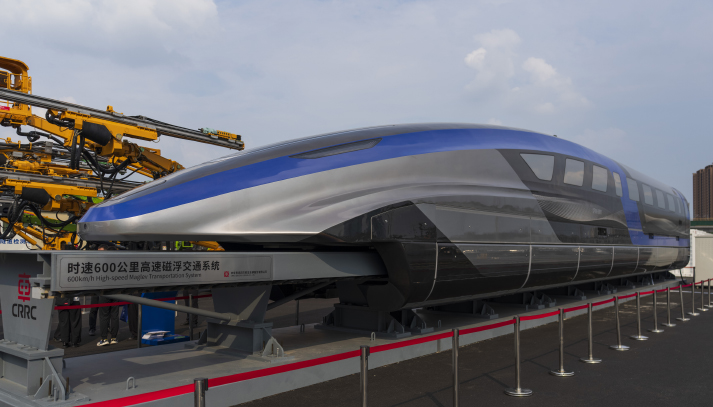| China |
| From humble beginnings to global frontrunner, China's rail revolution takes center stage at world congress | |
|
|
 Passengers aboard the Jakarta-Bandung High-Speed Railway, Southeast Asia's first bullet train line connecting Indonesia's two largest metropolitan areas, on June 19 (COURTESY PHOTO)
Fifteen years ago, when China hosted the Seventh World Congress on High-Speed Rail in Beijing, its high-speed rail network spanned just 7,531 km. Now, as the event made its return to China, the nation has an operational high-speed rail network of 48,000 km, reaching 97 percent of cities with over 500,000 residents and accounting for over 70 percent of the world's total. Over the past 15 years, China's high-speed rail mileage has increased more than fivefold, reshaping the global landscape. The 12th World Congress on High-Speed Rail, co-hosted by China State Railway Group Co. Ltd. (China Railway), the national railway operator, and the International Union of Railways, or UIC, the organization's French acronym, was held in Beijing from July 8 to 11. It featured technical forums, roundtable discussions and an international railway technology exhibition. Initiated by the UIC in 1992, the World Congress on High-Speed Rail is held every two to three years. Having been successfully held 11 times, it has become a global gathering for showcasing and exchanging achievements in high-speed rail development worldwide. High-speed growth "China, with over two thirds of the world's operational high-speed network, is a global leader and a source of inspiration," Alan Beroud, Chairman of the UIC, said at the opening ceremony. "In less than two decades, China has created the largest and most advanced high-speed rail system in the world, reshaping mobility, the economy and regional development." Speaking at the opening ceremony, Wang Lixin, Vice President of China Railway, emphasized the country's commitment to high-quality growth. He noted that after years of technological breakthroughs, China has developed a complete, end-to-end high-speed rail technology ecosystem, covering everything from infrastructure engineering and equipment manufacturing to operational management. China has also successfully developed the Fuxing series of electric multiple units (EMUs), featuring multiple speed configurations and adaptability to diverse environments, from high-altitude plateaus and frigid zones to sandstorm-prone regions. Wang highlighted key projects such as the Beijing-Shanghai line, enabling four-hour travel between the two major economic hubs, and the Harbin-Dalian line, which operates year-round through regions with extreme winter temperatures, demonstrating the system's resilience and engineering strength. Looking to the future, he affirmed that China's high-speed rail will continue to focus on innovation in key areas: higher speeds, intelligent systems, enhanced safety and sustainable practices.  A superconducting maglev train, capable of speeds up to 600 km per hour, makes its public debut at the National Railway Test Center on July 9 during the 12th World Congress on High-Speed Rail (COURTESY PHOTO)
Faster, smarter, greener A superconducting maglev train, capable of reaching 600 km per hour, publicly debuted at the National Railway Test Center during this year's congress. This revolutionary transport technology, which levitates above tracks using magnetic fields rather than rolling on wheels, could slash travel time between Shanghai and Beijing to just two and a half hours—rivaling domestic flight times. The project is making steady progress, with the first engineering prototype completed in July 2024, Shao Nan, a senior engineer at CRRC Changchun Railway Vehicles Co. Ltd., told reporters at the center on July 9. The train features a streamlined body constructed from high-strength aluminum alloy and carbon fiber composites, effectively minimizing aerodynamic drag. Its suspension system supports both low-speed, wheel-based movement and high-speed magnetic levitation. It aims to bridge the gap between high-speed rail and air travel, offering a more efficient, safer, greener and more comfortable transportation option. China's CR450 EMU prototype, officially unveiled last December, was also showcased at the National Railway Test Center during the congress. It has a test speed of up to 450 km per hour and an operational speed of 400 km per hour. Compared to the CR400 EMU, it achieves a 10-percent reduction in car body weight, a 22-percent reduction in running resistance, a 20-percent reduction in energy consumption and a 4-percent improvement in traction efficiency. If trials proceed successfully, the CR450 is projected to enter commercial service in 2026. In addition to getting faster, China's high-speed train is also becoming greener. Last March, the world's first hydrogen-powered urban commuter train, independently developed by CRRC Changchun Railway Vehicles Co., underwent a trial run at 160 km per hour in Changchun, Jilin Province. Test results showed the train's average energy consumption was just 5 kilowatt-hours per km, and it operated safely and stably under temperatures ranging from minus 25 degrees Celsius to 35 degrees Celsius. "We are developing a 250-km-per-hour hydrogen-powered EMU, which is expected to officially roll off the production line by the end of this year," Shi Lei, a senior engineer at CRRC Changchun Railway Vehicles Co., told newspaper People's Daily. Utilizing hydrogen fuel cells distributed across the roof, the train can achieve a range of 1,000 km with a 30-minute hydrogen refueling, producing zero emissions during operation and recycling wastewater. AI technology is also playing a central role in high-speed rail development. The Fuxing Smart Bullet Train, which entered operation in 2021, leverages the Beidou Satellite Navigation System, the Chinese GPS equivalent, to achieve automatic driving at 350 km per hour for the first time in the world. International cooperation In addition to taking the lead in high-speed rail development, China has collaborated with over 40 countries and regions in Asia, Europe, North America and Africa on railway planning, design, construction and operation. For example, the Jakarta-Bandung High-Speed Railway (HSR) in Indonesia, the first of its kind in Southeast Asia, has carried over 10 million passengers since commencing operations in October 2023. This entire line utilizes Chinese technology. Dwiyana Slamet Riyadi, President Director of PT Kereta Cepat Indonesia-China, a joint venture consortium between Indonesian and Chinese state-owned firms that constructs and runs the HSR, stated at the conference that the travel time between Jakarta and Bandung has been reduced from over three hours to approximately 40 minutes, transforming intercity travel into convenient commuting. Sommad Pholsena, Vice President of the National Assembly of Laos, who participated in the planning and construction of the China-Laos Railway connecting Kunming in southwest China and Vientiane, capital of Laos, remarked at the conference that the railway is not only a strategic corridor linking Laos and China but also a vital gateway connecting Laos to the wider world. As of May this year, the railway had transported a cumulative total of over 53 million passengers and over 13 million tons of cargo for cross-border transportation. China has also spearheaded the development of all 13 system-level international standards for high-speed rail set by the UIC, systematically improving the high-speed rail technical standard system. These 13 standards cover all aspects of high-speed rail, from design and construction to operation and infrastructure. Global high-speed rail is entering a new phase of expansion. The World High-Speed Rail Development Report, released by the UIC at the congress, projects an average annual growth rate of around 5 percent for the global railway network over the next five to six years. "We will steadily advance the construction and operation of overseas railway projects, ensuring that the benefits of high-speed rail construction and development extend to more regions and people," Song Xiude, General Manager of China Railway, told newspaper Economic Information Daily. Copyedited by Elsbeth van Paridon Comments to jijing@cicgamericas.com |
|
||||||||||||||||||||||||||||||
|